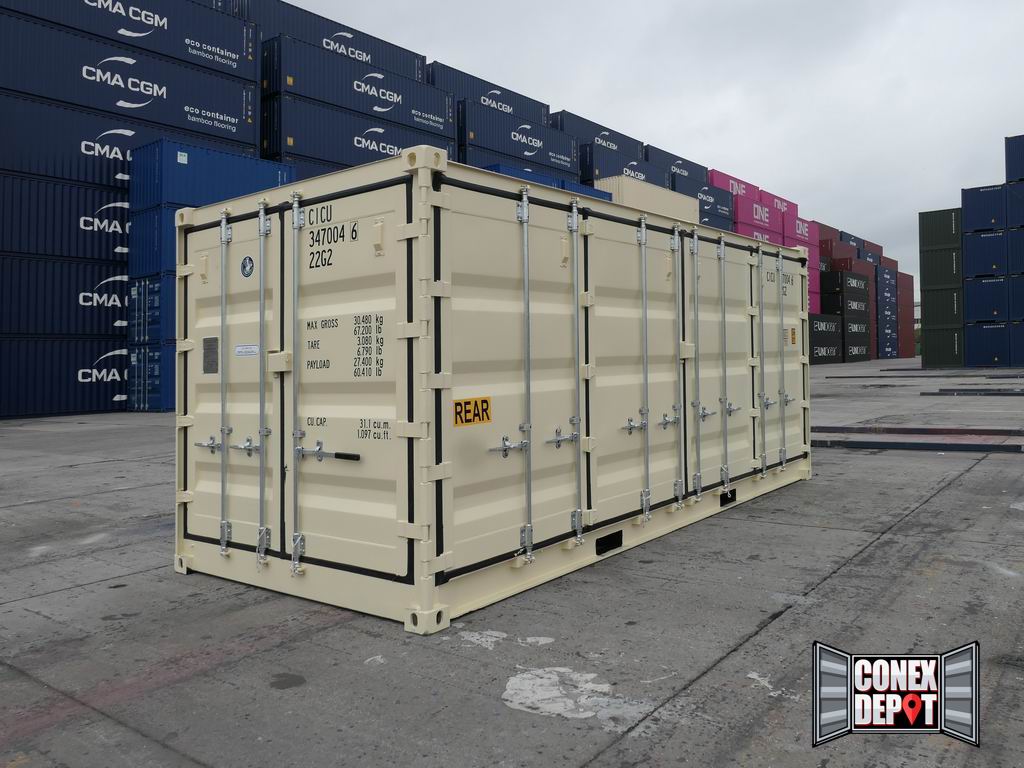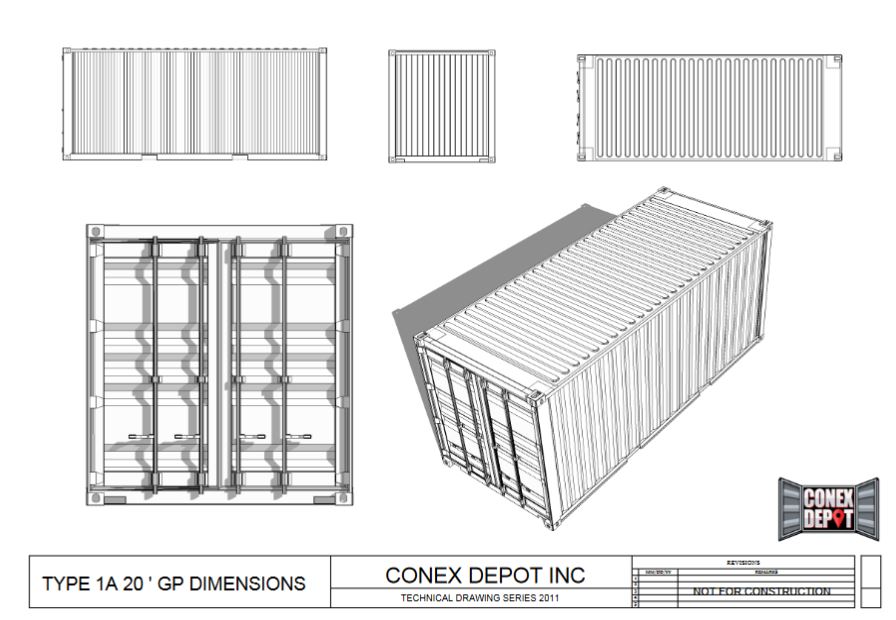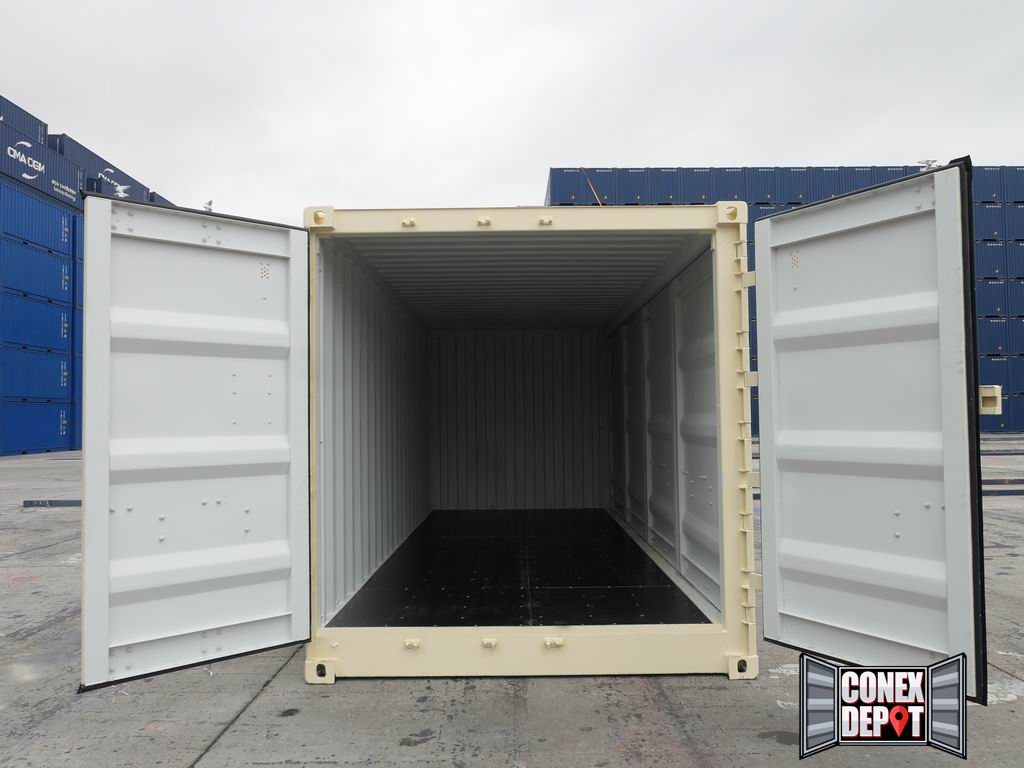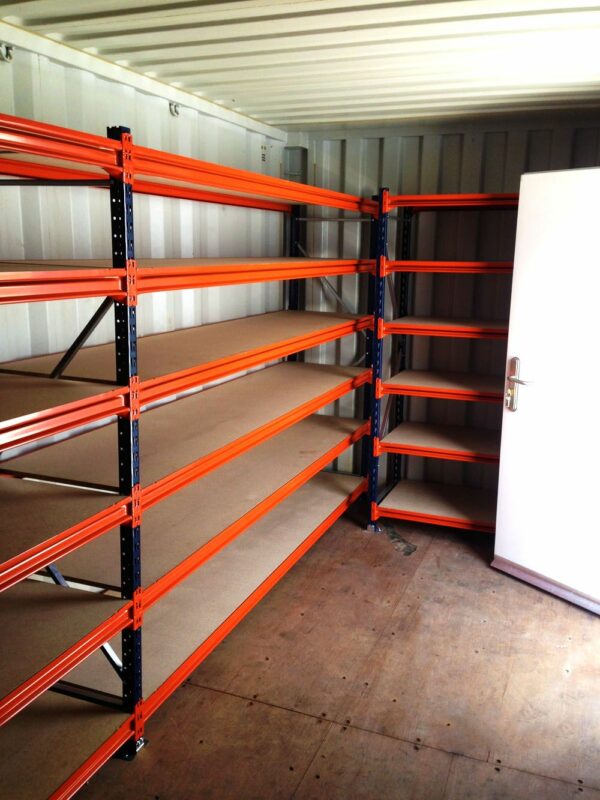Shipping Containers For Sale
Shipping Container Storage Common Questions
Shipping Container Storage Questions & Answers
Are you searching for answers to your questions about buying a used shipping container for storage?
ConexDepot Blog has assembled some of the most common questions that our customers ask about shipping container storage and shipping container businesses.

This week we answer your questions on the sizes of shipping containers, how much you can store in your used shipping container, what types of things you can and can not store in a shipping container, and whether it is necessary to insulate your cargo container to protect your stored items.
Read more: Shipping Container Home Storage Ideas
Q: How big is a shipping container, and how much stuff can it hold?
Many of Conex Depot’s customers are homeowners and business owners who need a used shipping container for storage for their home items during a renovation or move or business owners who need convenient and secure storage space for their inventory.
What size of Conex container do you need for your storage needs? We can answer this question in two ways: the technical measurements and some simple rules of thumb for how much stuff a 20 ft and 40 ft cargo container will hold.
What are shipping container sizes? The two most common sizes of used shipping containers are the 20 ft and the 40 ft. The standard width is 8 feet with a height of 8 feet 6 inches.
20 ft shipping container
By far, the most popular size for home storage is a 20ft container. Measuring 6m/ 20ft x 2.4m /8ft (length x width), it has 1,172 cubic feet (33.2m). 150 square feet of floor space.
A 20-foot shipping container may hold the contents of a standard 3-bedroom home (furniture, home entertainment, beds, boxes, and the rest of your possessions) as a general rule of thumb. The 20 ft steel container is our most popular seller for homeowners that need temporary storage space for their household items during a home renovation project.
For full shipping container size specifications, check out: https://www.conexdepot.com/specifications/
In reality, you will have about 25-28 cbm of usable space inside the container once the thickness of walls and other factors are subtracted from the total volume. It’s difficult to visualize what 25 cbm means in terms of how much space you will have.
Those cardboard boxes that you get from home movers are a convenient way of understanding how much stuff can fit in your shipping container. storage.One moving company calculated that 310 standard cardboard moving boxes could be stored in a 20 ft shipping container.
For comparison, a 20 ft shipping container can store the equivalent of
50-60 refrigerators or
100 washing machines, or
400 flat-screen TVs. That’s A LOT of storage space!

How many containers do I need for a 4-bedroom house?
The contents of the average four-bedroom home may need two 20′ containers- or a single 40′ for larger homes or if you also need to store seasonal items like outdoor furniture and groundskeeping and gardening equipment..
40 ft shipping container
The biggest of the standard available shipping containers is the 40 ft. A 40-foot cargo container measures 12.2m /40ft (length x width), and it has 1,172 cubic feet (67.6m). 300 square feet of floor space.
While some homeowners need a larger 40 ft shipping container, we most often see the 40 ft size chosen for business use. Used shipping containers provide a movable, convenient, and secure storage area for business equipment and inventory.
A useful measurement to get an idea of how much stuff a 40 ft Conex box will hold is the standard wooden pallet. Depending on the type of pallet you are using, a 40 ft cargo container has room for 22 standard pallets (or 27 Euro pallets) without considering stacking the pallets.
What are the shipping container dimensions?
The most common height of a standard shipping container is 8 ft 6 ins. The rare “hi-cubes” is higher at 9 ft 6 ins in height and are becoming increasingly common.
External vs. internal measurements
Note that there is a difference between the commonly used external container dimensions and the internal container dimensions.
Thus far, we have referred to the standard “External Container Dimensions”. The “Internal Container Dimensions” are adjusted to account for a few design factors that limit the available space that you can actually use inside the shipping container. The walls of a shipping container are made of corrugated metal. The depth of the corrugation is usually 1 inch (25mm). Added up, the results in two inches (50mm) less space when measured on the interior of the container when compared to the external dimensions.
The doors of the shipping container are also corrugated. The doors measure 2 inches (50mm) thick – which means that you lose approximately 3 inches (75mm) of internal length compared to the external length measurement.
The most significant difference between external to internal dimensions comes to the height of the container. The floor of a Conex container has an “underside clearance” of 6 inches (150mm), and the floor has a thickness of 27mm a little over 1 inch). Since the roof is also corrugated, an additional 1 inch (25mm) must be subtracted from the external height measurement, resulting in a loss of around 8 inches (7ft 10 inches) between the usable space of the internal dimension and the standard external dimension.
Q: How much do shipping containers weigh?
While shipping containers are constructed out of Corten steel and obviously very heavy, the good news is that they are designed to be moved easily. The weight of the shipping container becomes important when it needs to be moved (obviously requiring a truck equipped to handle such a large and heavy load), but weight is also a factor when you need to rest the steel container on a particular surface that is capable of bearing its weight.
Shipping container weights explained
There are three important weights used when describing a shipping container:
Tare Weight
Gross Weight
Payload.
You will often see these numbers painted on the outside of the doors of shipping containers.
- The Tare Weight is the weight of the empty container without cargo or contents.
- The Gross Weight consists of the weight of the container plus the maximum payload it can hold i.e., the maximum total weight of the loaded container.
- The Payload (or Net Weight) is the weight of the cargo or contents that a container can hold.
Now that we understand what the numbers mean, here are the typical weights of steel Conex containers (see table below). A 20 ft Conex container is approximately 4780 pounds, and a 40 ft container weighs in at a whopping 8,270 pounds!
| Length | 10ft | 20ft | 40ft |
| Max Gross Weight | 11,300kg | 30,480kg* | 30,400kg |
| 24,910lbs | 67,200lbs | 67,200lbs | |
| Tare Weight | 1,300kg | 2,170kg | 3,750kg |
| 2,870lbs | 4,780lbs | 8,270lbs | |
| Payload (or Net Weight) | 10,000kg | 28,310kg | 26,730kg |
| 22,040lbs | 62,420lbs | 58,930lbs | |

Q: Can my items get wet or damaged in a shipping container?
Are shipping containers airtight?
A primary concern if you are storing household items or business inventory is the security of your goods. At ConexDepot, we frequently hear questions from our customers asking if their goods will be safe from possible water damage or other problems in less-than-secure storage space.
We have good news for you. Shipping containers are designed to be impervious to all sorts of extreme weather conditions on their long ocean voyages and, therefore, ideally equipped to safely store your items.
Wind and water-tight – WWT
A container is said to be wind and water-tight if no wind or water can get inside the container. This is the standard to which Conex boxes are designed and constructed from the beginning. The intended purpose of a steel shipping container is to store and protect a wide variety of perishable goods and keep them dry during long sea voyages where they are exposed to salt water and the elements.
These units can effectively protect against strong winds, rain, snow, and the bumps and bangs sustained during loading and unloading from the freight carriers.
When you first receive your shipping container, you should conduct a thorough inspection of the container to see if there are any obvious leaks, dents in the doors, or damage in the walls that result in holes that will provide openings for moisture to enter the container. This is not common in a Conex box that is in good condition. However, overlooking this can result in water entering the container on the first rainy day and an unpleasant surprise when your goods get wet.
Can my goods develop mold when stored in a shipping container?
What causes mold in a container?
Moisture in the air inside the container can lead to mold development. Mold is a product of high humidity (above 50%) in a confined space lacking sufficient ventilation. If you store wet items in a closed container for any length of time, you will likely have to deal with mold growth. Even if your container is tightly sealed, there is still oxygen inside that will enable mold to grow. Mold spores are microscopic in nature ( as small as 4 microns) and present in the air. The spores can easily come in with your stored items and await the conditions they need to propagate into a mold problem.
Mold, mildew, and rust are all common issues that can occur at the same time. All of these problems can pose a threat to your stored items. In fact, Any natural materials (linens, fabrics, paper, etc.) and particularly electronics, are vulnerable to the negative effects of mold formation.
This can largely be avoided by taking a few different precautions.
Make sure that the items you are packing in the container are dry to start with.
Additionally, storing your possessions in waterproof boxes or with desiccants like silica gel packs (available at big hardware stores) will help prevent mold from gaining a foothold.
Many of ConexDepot’s customers who bought a shipping container for home storage have installed portable shelves inside their containers. This not only expands the storage space and helps organize things, but it also keeps items off of the floor and prevents your things from sitting in any water that may have collected on the shipping container floor.
Preventing moisture from forming in your shipping container storage in the first place is the most effective way to avoid mold problems. How do you control moisture inside of your shipping container?
Are shipping containers insulated?
While your shipping container was designed to be wind and water-tight, they are formed out of bare metal walls and thus not well insulated. Everyday weather fluctuations, such as changes in outside temperature and humidity, can cause moisture present in the air to condense and collect inside your container storage. Depending on the area of the USA where you are located, you may be dealing with the extremes of freezing temperatures in the winter and soaring temperatures in the hot weather months.
The solution is to provide adequate ventilation and possibly look into adding some insulation to your container.
Read our full guide on How To Insulate A Shipping Container
What is a vapor barrier?
Creating a Vapor Barrier
The interior walls of a shipping container can “sweat,” – which means water condenses on the inside surfaces caused by temperature changes. A vapor barrier is any material employed for purposes of damp proofing. Most commonly, a plastic sheet is used that prevents the diffusion of moisture through the container walls.
All shipping containers will come equipped with a few cargo vents to allow for airflow as the container is transported from warm to cooler climates and to allow the containers to breathe as the internal air expands and contracts along with external temperature changes. If you live in a humid climate, you should look into installing a simple vapor barrier.

Q: Is there anything I should NOT store in my shipping container?
Shipping containers are used to transport an innumerable variety of different goods. For the vast majority of the items that you would need to store, a shipping container is perfectly safe.
Having said that, there are certain types of items that require special attention if you intend to store them for long periods in a cargo container, and some items are not recommended. Many of these are obvious but bear mentioning.
Storing flammable items, in general, requires certain precautions. In the event of a fire, the losses can be catastrophic and very dangerous. If you need to store flammable items, ensure that there is adequate ventilation to prevent fumes from accumulating. The possibility of liquid spills that create a fire hazard must be accounted for,
Dangerous chemicals. Anything that releases poisonous gasses that disperse into the air requires special handling. A build-up of these gasses in the enclosed space of a shipping container is a health hazard. You should know what you are doing if you are storing toxic chemicals. These chemicals can potentially seriously damage the other goods inside of your container if stored improperly.
Perishable items and organic materials could attract pests. Your container is tightly sealed, and pests will have a difficult time gaining entry to the container, but rodents and other pests will be attracted to the smells and can even be hidden inside the items when they are initially stored in the container. Moreover, temperature changes can promote decay and other forms of rot in many organic substances.
Household Items. Of course, it’s fine to store household items in your shipping container. When storing household items, sufficient ventilation IS crucial to prevent problems caused by excess moisture trapped inside the container. Your precious possessions can potentially warp, get moldy, and show mildew if exposed to excessive moisture. Proper packing of your things can lower the possibility of damage, but packing can not guarantee immunity like proper moisture ventilation will.
Heavy Machinery & Automobiles
Storing heavy machinery and automobiles need a properly ventilated storage area to ensure that they will operate without problems after a long storage period. Keeping machinery at a safe temperature range and allowing air circulation is the best practices. Extreme temperature fluctuations can adversely affect the integrity of machinery and potentially cause damage. As we have seen with other stored items, if moisture is not managed inside the shipping container, rust, corrosion, and mold could develop,
Volatile Chemicals / Pressurized Gasses
This class of materials requires specialized knowledge in order to handle safely. In some industries, chemicals and pressurized gas tanks are common tools. It’s recommended to check the safety requirements for the safe storage of chemicals before locking them up in your Conex container. An expert can advise which chemicals that are not safe to be stored in an enclosed space under normal circumstances.
Contact us with your questions about buying a used shipping container for storage.



 Quick Quote
Quick Quote